University Assignment: Porter's Diamond FDI Analysis of India
VerifiedAdded on 2022/09/18
|13
|3541
|17
Report
AI Summary
This report analyzes the Indian telecommunication market through the lens of Porter's Diamond Model to assess its suitability for Foreign Direct Investment (FDI) by ABC Technologies LLC. The introduction highlights the firm's focus on the digitized consumer goods market in India, particularly targeting the youth population and online purchases. The report then delves into Porter's Diamond Model, examining firm strategy, structure, and rivalry within the Indian telecom sector, including key players like Reliance Jio, Airtel, and Vodafone. It assesses factor endowments, emphasizing the large youth population and the availability of human resources, while also acknowledging the need for skilled labor. The report evaluates demand conditions, highlighting the rapid growth of the Indian telecom market and the increasing mobile usage and data consumption. It also analyzes related and supporting industries, such as hardware, software, and research centers. The report concludes by emphasizing the potential of the Indian telecom market for FDI and the importance of strategic alignment with the Porter's Diamond Model to achieve a competitive advantage. The analysis covers various aspects, including market capitalization, competition, government policies, and the impact of globalization on the Indian telecom sector.
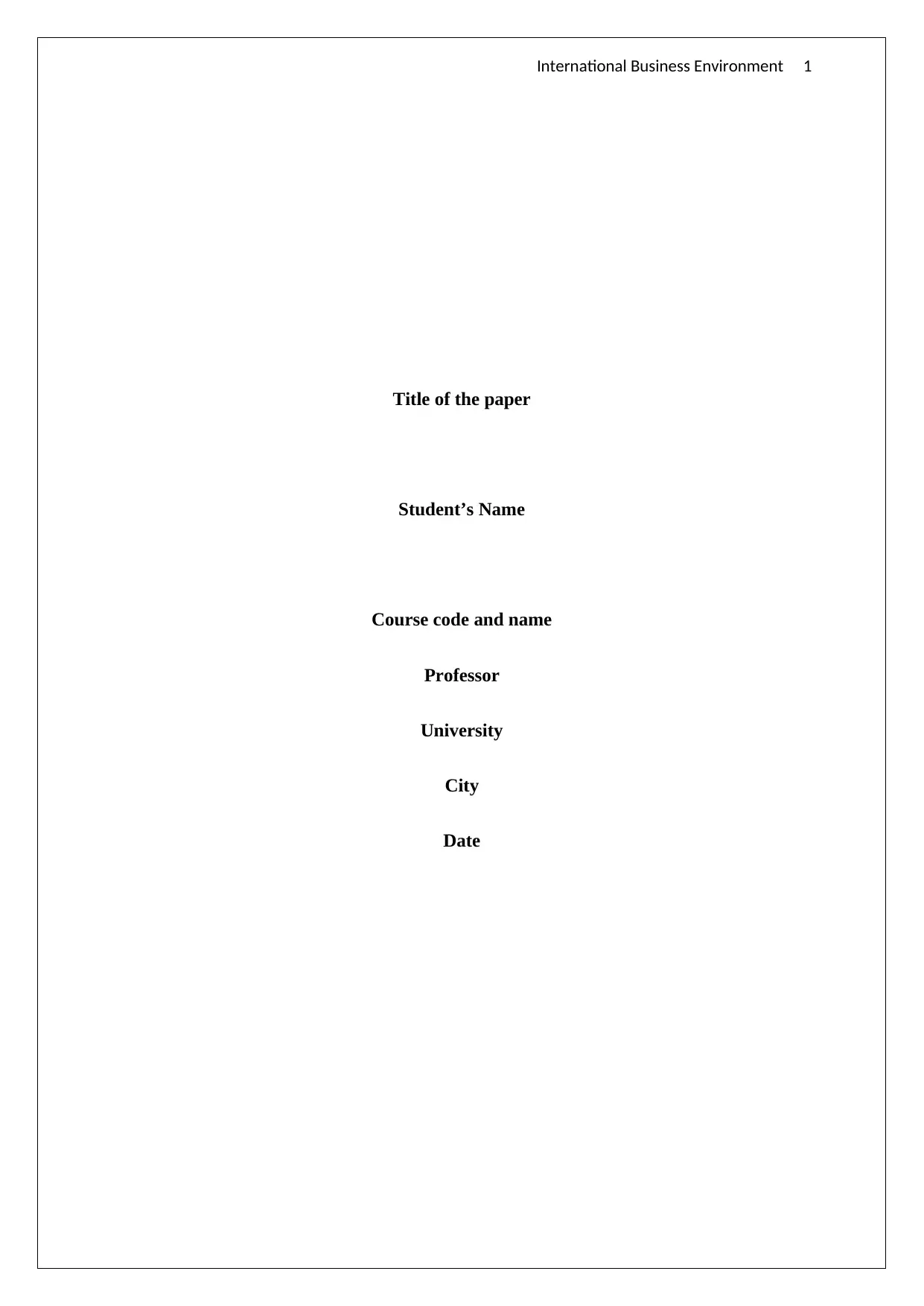
International Business Environment 1
Title of the paper
Student’s Name
Course code and name
Professor
University
City
Date
Title of the paper
Student’s Name
Course code and name
Professor
University
City
Date
Paraphrase This Document
Need a fresh take? Get an instant paraphrase of this document with our AI Paraphraser
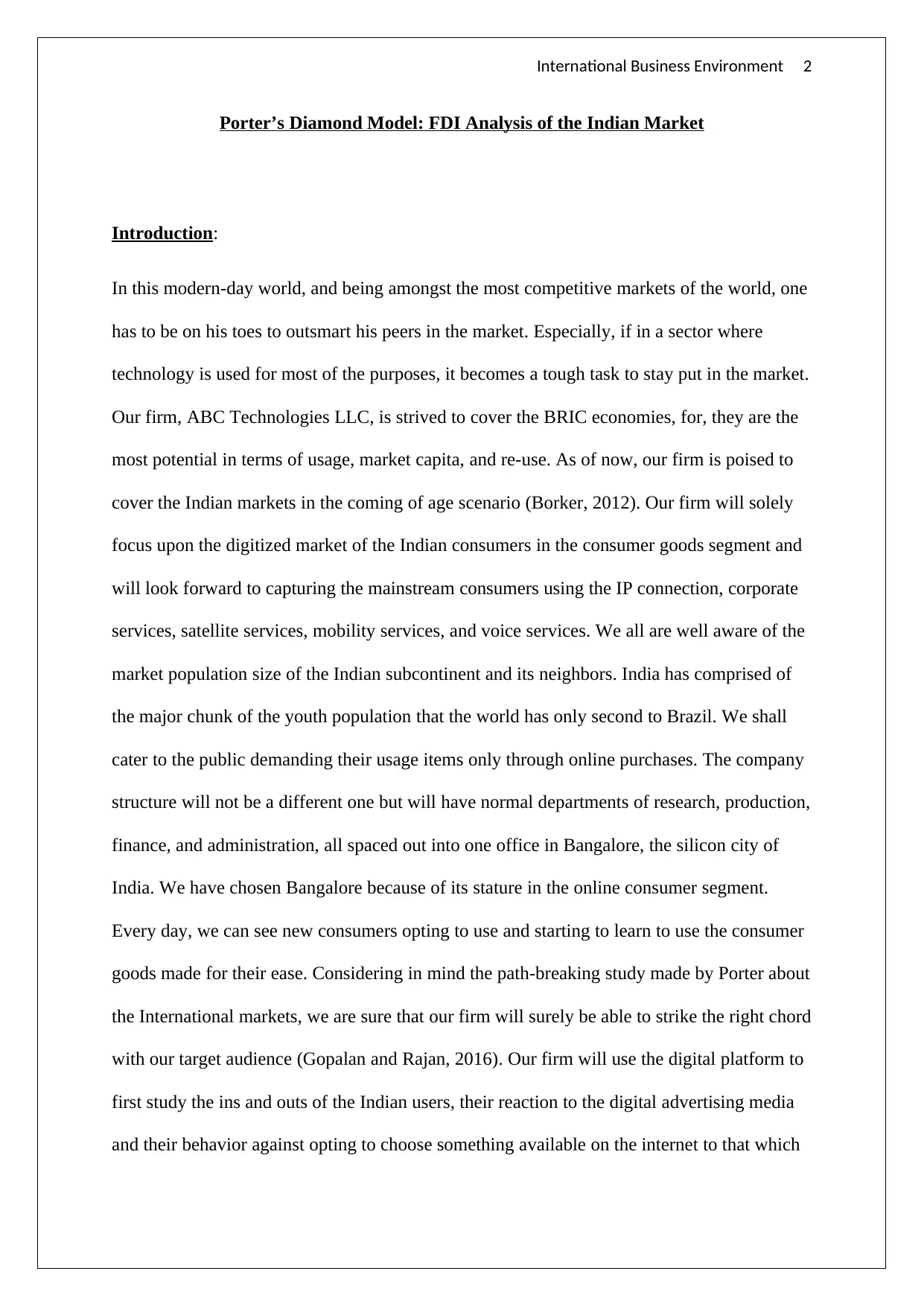
International Business Environment 2
Porter’s Diamond Model: FDI Analysis of the Indian Market
Introduction:
In this modern-day world, and being amongst the most competitive markets of the world, one
has to be on his toes to outsmart his peers in the market. Especially, if in a sector where
technology is used for most of the purposes, it becomes a tough task to stay put in the market.
Our firm, ABC Technologies LLC, is strived to cover the BRIC economies, for, they are the
most potential in terms of usage, market capita, and re-use. As of now, our firm is poised to
cover the Indian markets in the coming of age scenario (Borker, 2012). Our firm will solely
focus upon the digitized market of the Indian consumers in the consumer goods segment and
will look forward to capturing the mainstream consumers using the IP connection, corporate
services, satellite services, mobility services, and voice services. We all are well aware of the
market population size of the Indian subcontinent and its neighbors. India has comprised of
the major chunk of the youth population that the world has only second to Brazil. We shall
cater to the public demanding their usage items only through online purchases. The company
structure will not be a different one but will have normal departments of research, production,
finance, and administration, all spaced out into one office in Bangalore, the silicon city of
India. We have chosen Bangalore because of its stature in the online consumer segment.
Every day, we can see new consumers opting to use and starting to learn to use the consumer
goods made for their ease. Considering in mind the path-breaking study made by Porter about
the International markets, we are sure that our firm will surely be able to strike the right chord
with our target audience (Gopalan and Rajan, 2016). Our firm will use the digital platform to
first study the ins and outs of the Indian users, their reaction to the digital advertising media
and their behavior against opting to choose something available on the internet to that which
Porter’s Diamond Model: FDI Analysis of the Indian Market
Introduction:
In this modern-day world, and being amongst the most competitive markets of the world, one
has to be on his toes to outsmart his peers in the market. Especially, if in a sector where
technology is used for most of the purposes, it becomes a tough task to stay put in the market.
Our firm, ABC Technologies LLC, is strived to cover the BRIC economies, for, they are the
most potential in terms of usage, market capita, and re-use. As of now, our firm is poised to
cover the Indian markets in the coming of age scenario (Borker, 2012). Our firm will solely
focus upon the digitized market of the Indian consumers in the consumer goods segment and
will look forward to capturing the mainstream consumers using the IP connection, corporate
services, satellite services, mobility services, and voice services. We all are well aware of the
market population size of the Indian subcontinent and its neighbors. India has comprised of
the major chunk of the youth population that the world has only second to Brazil. We shall
cater to the public demanding their usage items only through online purchases. The company
structure will not be a different one but will have normal departments of research, production,
finance, and administration, all spaced out into one office in Bangalore, the silicon city of
India. We have chosen Bangalore because of its stature in the online consumer segment.
Every day, we can see new consumers opting to use and starting to learn to use the consumer
goods made for their ease. Considering in mind the path-breaking study made by Porter about
the International markets, we are sure that our firm will surely be able to strike the right chord
with our target audience (Gopalan and Rajan, 2016). Our firm will use the digital platform to
first study the ins and outs of the Indian users, their reaction to the digital advertising media
and their behavior against opting to choose something available on the internet to that which
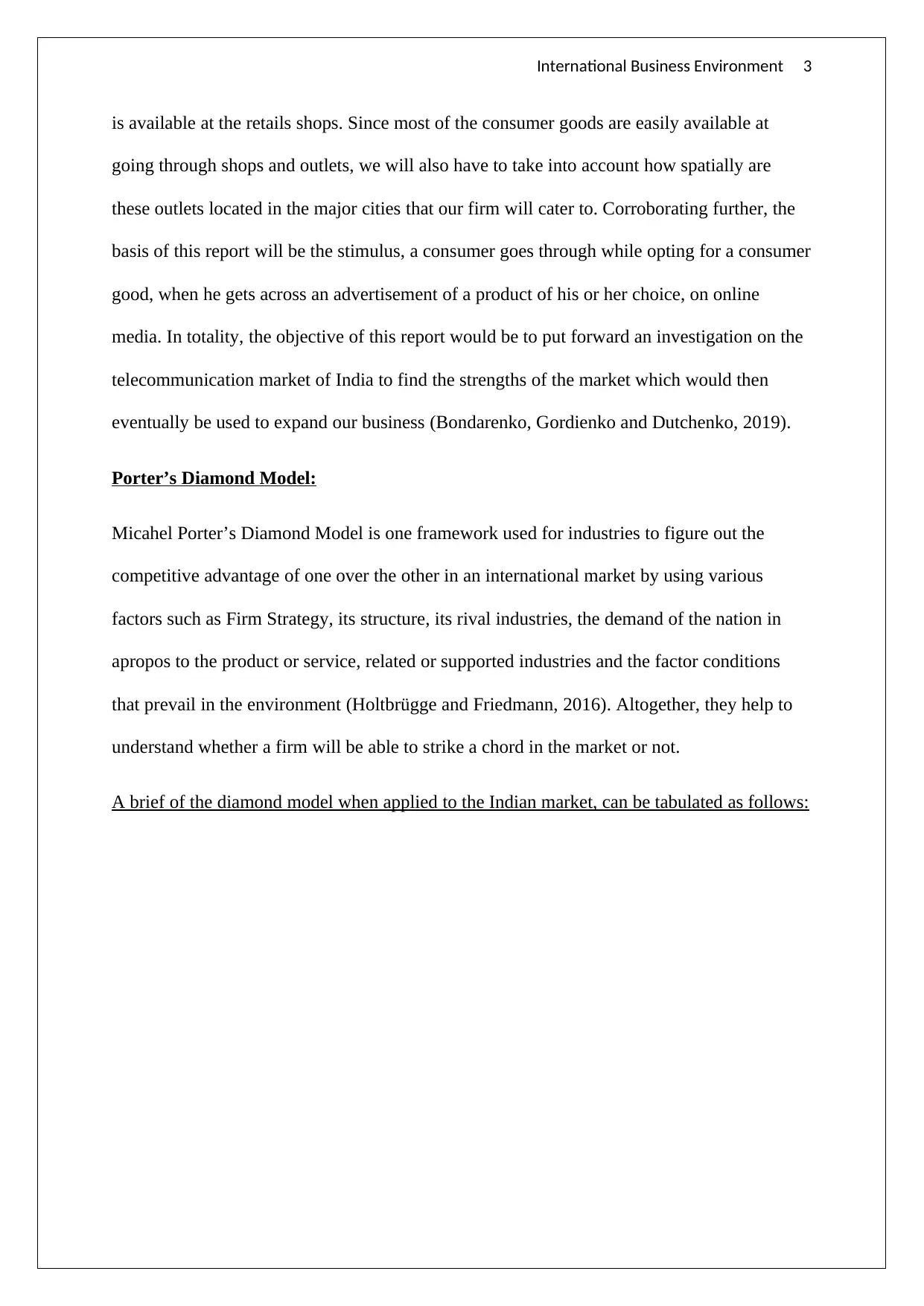
International Business Environment 3
is available at the retails shops. Since most of the consumer goods are easily available at
going through shops and outlets, we will also have to take into account how spatially are
these outlets located in the major cities that our firm will cater to. Corroborating further, the
basis of this report will be the stimulus, a consumer goes through while opting for a consumer
good, when he gets across an advertisement of a product of his or her choice, on online
media. In totality, the objective of this report would be to put forward an investigation on the
telecommunication market of India to find the strengths of the market which would then
eventually be used to expand our business (Bondarenko, Gordienko and Dutchenko, 2019).
Porter’s Diamond Model:
Micahel Porter’s Diamond Model is one framework used for industries to figure out the
competitive advantage of one over the other in an international market by using various
factors such as Firm Strategy, its structure, its rival industries, the demand of the nation in
apropos to the product or service, related or supported industries and the factor conditions
that prevail in the environment (Holtbrügge and Friedmann, 2016). Altogether, they help to
understand whether a firm will be able to strike a chord in the market or not.
A brief of the diamond model when applied to the Indian market, can be tabulated as follows:
is available at the retails shops. Since most of the consumer goods are easily available at
going through shops and outlets, we will also have to take into account how spatially are
these outlets located in the major cities that our firm will cater to. Corroborating further, the
basis of this report will be the stimulus, a consumer goes through while opting for a consumer
good, when he gets across an advertisement of a product of his or her choice, on online
media. In totality, the objective of this report would be to put forward an investigation on the
telecommunication market of India to find the strengths of the market which would then
eventually be used to expand our business (Bondarenko, Gordienko and Dutchenko, 2019).
Porter’s Diamond Model:
Micahel Porter’s Diamond Model is one framework used for industries to figure out the
competitive advantage of one over the other in an international market by using various
factors such as Firm Strategy, its structure, its rival industries, the demand of the nation in
apropos to the product or service, related or supported industries and the factor conditions
that prevail in the environment (Holtbrügge and Friedmann, 2016). Altogether, they help to
understand whether a firm will be able to strike a chord in the market or not.
A brief of the diamond model when applied to the Indian market, can be tabulated as follows:
⊘ This is a preview!⊘
Do you want full access?
Subscribe today to unlock all pages.

Trusted by 1+ million students worldwide
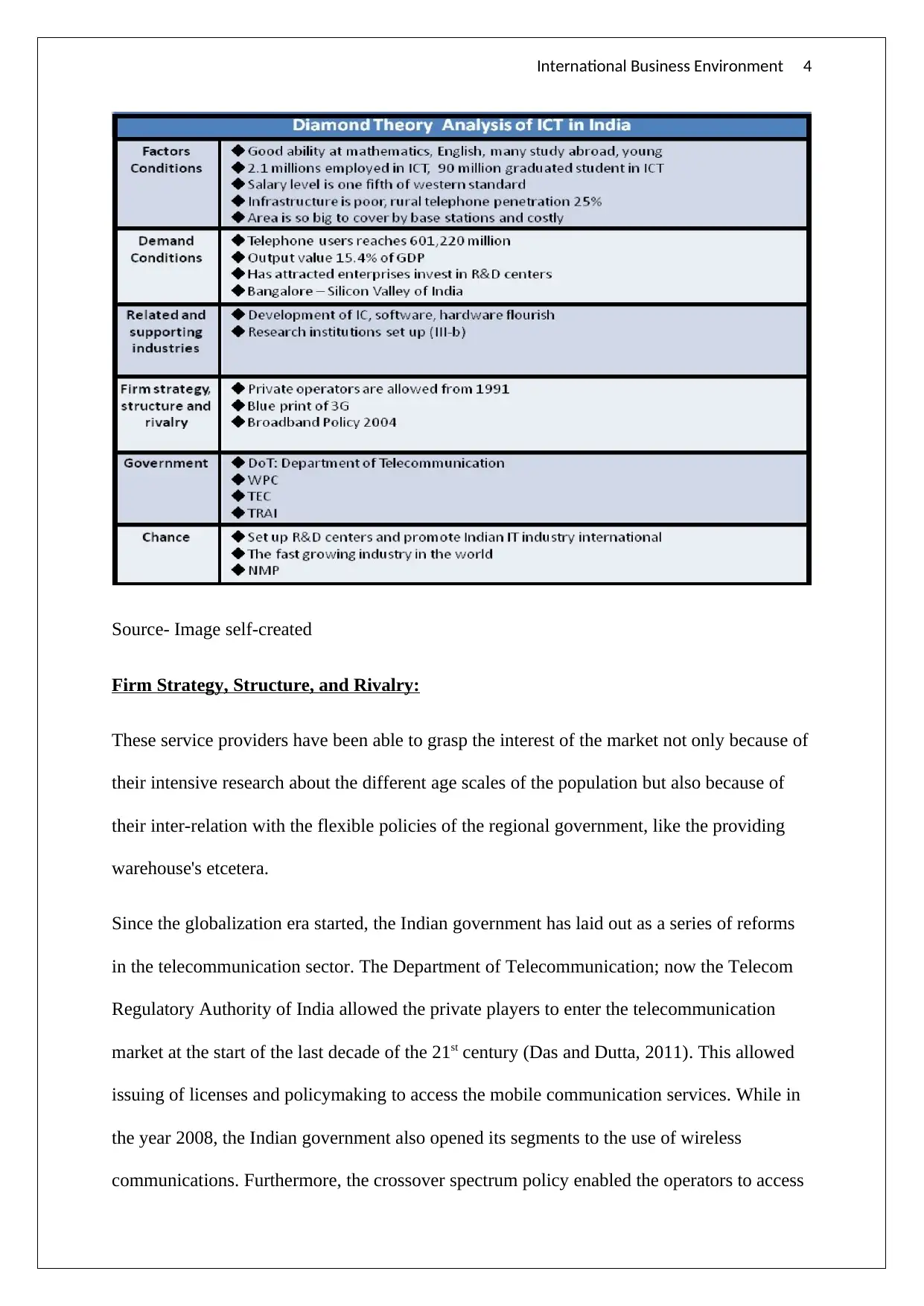
International Business Environment 4
Source- Image self-created
Firm Strategy, Structure, and Rivalry:
These service providers have been able to grasp the interest of the market not only because of
their intensive research about the different age scales of the population but also because of
their inter-relation with the flexible policies of the regional government, like the providing
warehouse's etcetera.
Since the globalization era started, the Indian government has laid out as a series of reforms
in the telecommunication sector. The Department of Telecommunication; now the Telecom
Regulatory Authority of India allowed the private players to enter the telecommunication
market at the start of the last decade of the 21st century (Das and Dutta, 2011). This allowed
issuing of licenses and policymaking to access the mobile communication services. While in
the year 2008, the Indian government also opened its segments to the use of wireless
communications. Furthermore, the crossover spectrum policy enabled the operators to access
Source- Image self-created
Firm Strategy, Structure, and Rivalry:
These service providers have been able to grasp the interest of the market not only because of
their intensive research about the different age scales of the population but also because of
their inter-relation with the flexible policies of the regional government, like the providing
warehouse's etcetera.
Since the globalization era started, the Indian government has laid out as a series of reforms
in the telecommunication sector. The Department of Telecommunication; now the Telecom
Regulatory Authority of India allowed the private players to enter the telecommunication
market at the start of the last decade of the 21st century (Das and Dutta, 2011). This allowed
issuing of licenses and policymaking to access the mobile communication services. While in
the year 2008, the Indian government also opened its segments to the use of wireless
communications. Furthermore, the crossover spectrum policy enabled the operators to access
Paraphrase This Document
Need a fresh take? Get an instant paraphrase of this document with our AI Paraphraser
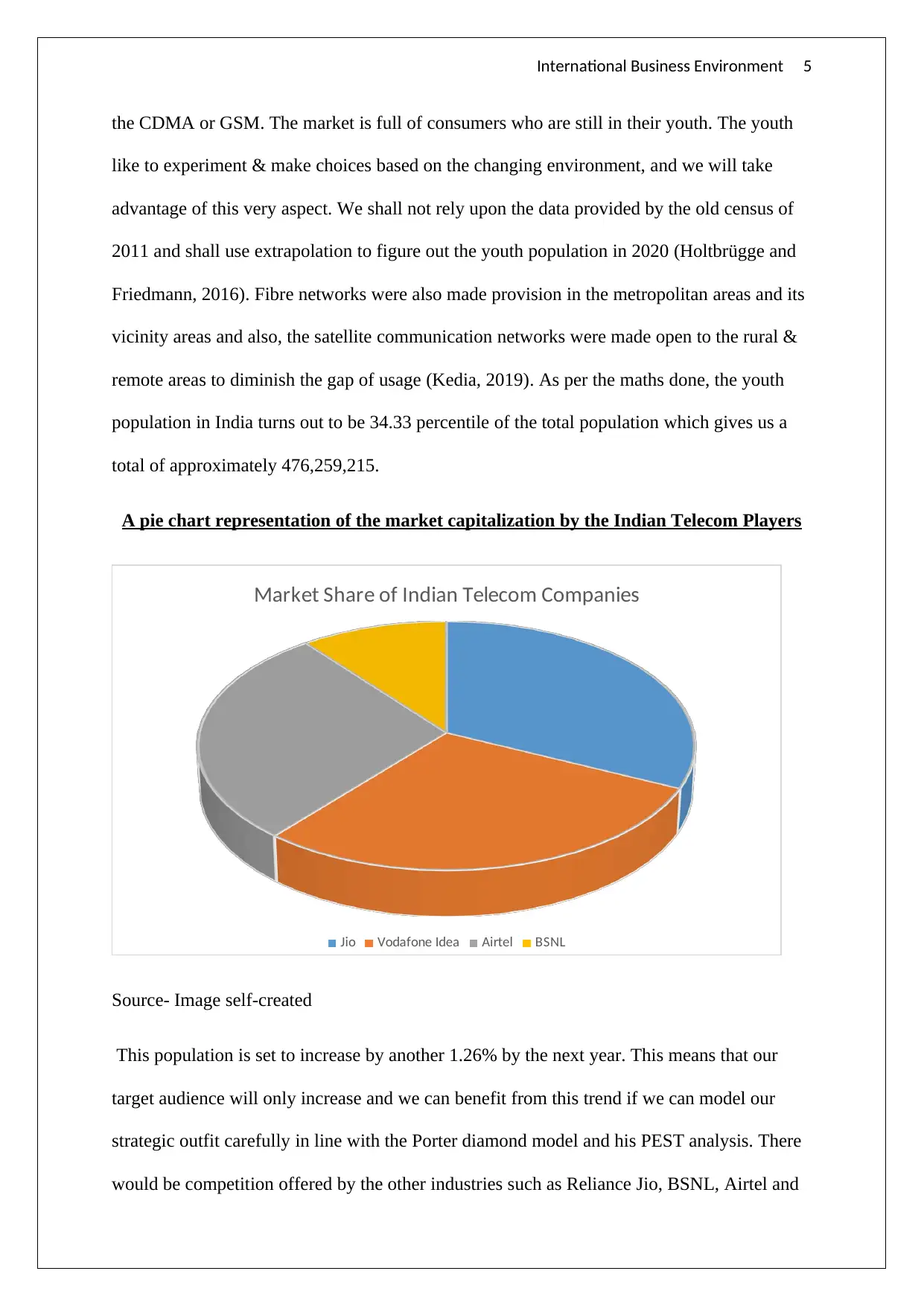
International Business Environment 5
the CDMA or GSM. The market is full of consumers who are still in their youth. The youth
like to experiment & make choices based on the changing environment, and we will take
advantage of this very aspect. We shall not rely upon the data provided by the old census of
2011 and shall use extrapolation to figure out the youth population in 2020 (Holtbrügge and
Friedmann, 2016). Fibre networks were also made provision in the metropolitan areas and its
vicinity areas and also, the satellite communication networks were made open to the rural &
remote areas to diminish the gap of usage (Kedia, 2019). As per the maths done, the youth
population in India turns out to be 34.33 percentile of the total population which gives us a
total of approximately 476,259,215.
A pie chart representation of the market capitalization by the Indian Telecom Players
Market Share of Indian Telecom Companies
Jio Vodafone Idea Airtel BSNL
Source- Image self-created
This population is set to increase by another 1.26% by the next year. This means that our
target audience will only increase and we can benefit from this trend if we can model our
strategic outfit carefully in line with the Porter diamond model and his PEST analysis. There
would be competition offered by the other industries such as Reliance Jio, BSNL, Airtel and
the CDMA or GSM. The market is full of consumers who are still in their youth. The youth
like to experiment & make choices based on the changing environment, and we will take
advantage of this very aspect. We shall not rely upon the data provided by the old census of
2011 and shall use extrapolation to figure out the youth population in 2020 (Holtbrügge and
Friedmann, 2016). Fibre networks were also made provision in the metropolitan areas and its
vicinity areas and also, the satellite communication networks were made open to the rural &
remote areas to diminish the gap of usage (Kedia, 2019). As per the maths done, the youth
population in India turns out to be 34.33 percentile of the total population which gives us a
total of approximately 476,259,215.
A pie chart representation of the market capitalization by the Indian Telecom Players
Market Share of Indian Telecom Companies
Jio Vodafone Idea Airtel BSNL
Source- Image self-created
This population is set to increase by another 1.26% by the next year. This means that our
target audience will only increase and we can benefit from this trend if we can model our
strategic outfit carefully in line with the Porter diamond model and his PEST analysis. There
would be competition offered by the other industries such as Reliance Jio, BSNL, Airtel and
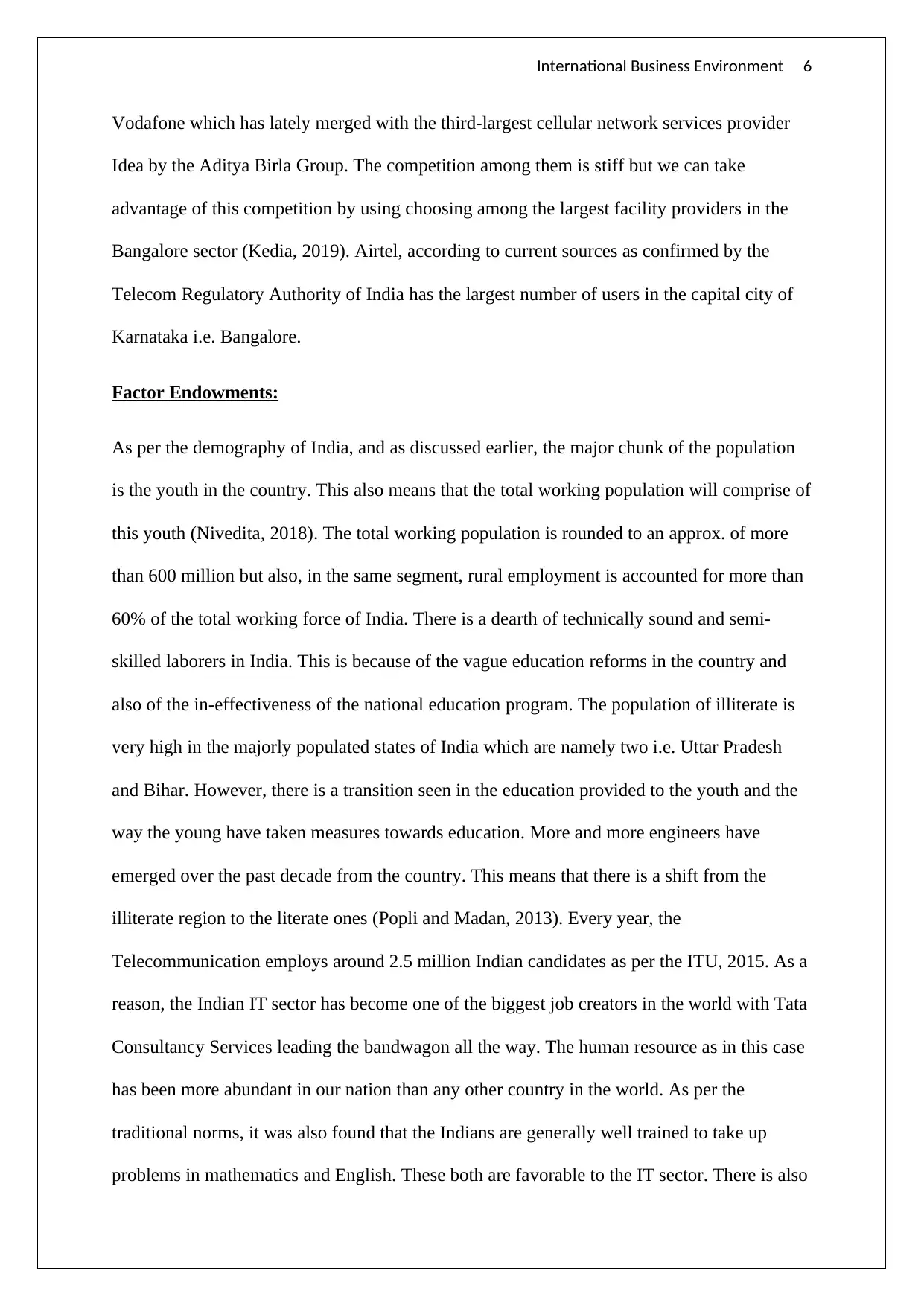
International Business Environment 6
Vodafone which has lately merged with the third-largest cellular network services provider
Idea by the Aditya Birla Group. The competition among them is stiff but we can take
advantage of this competition by using choosing among the largest facility providers in the
Bangalore sector (Kedia, 2019). Airtel, according to current sources as confirmed by the
Telecom Regulatory Authority of India has the largest number of users in the capital city of
Karnataka i.e. Bangalore.
Factor Endowments:
As per the demography of India, and as discussed earlier, the major chunk of the population
is the youth in the country. This also means that the total working population will comprise of
this youth (Nivedita, 2018). The total working population is rounded to an approx. of more
than 600 million but also, in the same segment, rural employment is accounted for more than
60% of the total working force of India. There is a dearth of technically sound and semi-
skilled laborers in India. This is because of the vague education reforms in the country and
also of the in-effectiveness of the national education program. The population of illiterate is
very high in the majorly populated states of India which are namely two i.e. Uttar Pradesh
and Bihar. However, there is a transition seen in the education provided to the youth and the
way the young have taken measures towards education. More and more engineers have
emerged over the past decade from the country. This means that there is a shift from the
illiterate region to the literate ones (Popli and Madan, 2013). Every year, the
Telecommunication employs around 2.5 million Indian candidates as per the ITU, 2015. As a
reason, the Indian IT sector has become one of the biggest job creators in the world with Tata
Consultancy Services leading the bandwagon all the way. The human resource as in this case
has been more abundant in our nation than any other country in the world. As per the
traditional norms, it was also found that the Indians are generally well trained to take up
problems in mathematics and English. These both are favorable to the IT sector. There is also
Vodafone which has lately merged with the third-largest cellular network services provider
Idea by the Aditya Birla Group. The competition among them is stiff but we can take
advantage of this competition by using choosing among the largest facility providers in the
Bangalore sector (Kedia, 2019). Airtel, according to current sources as confirmed by the
Telecom Regulatory Authority of India has the largest number of users in the capital city of
Karnataka i.e. Bangalore.
Factor Endowments:
As per the demography of India, and as discussed earlier, the major chunk of the population
is the youth in the country. This also means that the total working population will comprise of
this youth (Nivedita, 2018). The total working population is rounded to an approx. of more
than 600 million but also, in the same segment, rural employment is accounted for more than
60% of the total working force of India. There is a dearth of technically sound and semi-
skilled laborers in India. This is because of the vague education reforms in the country and
also of the in-effectiveness of the national education program. The population of illiterate is
very high in the majorly populated states of India which are namely two i.e. Uttar Pradesh
and Bihar. However, there is a transition seen in the education provided to the youth and the
way the young have taken measures towards education. More and more engineers have
emerged over the past decade from the country. This means that there is a shift from the
illiterate region to the literate ones (Popli and Madan, 2013). Every year, the
Telecommunication employs around 2.5 million Indian candidates as per the ITU, 2015. As a
reason, the Indian IT sector has become one of the biggest job creators in the world with Tata
Consultancy Services leading the bandwagon all the way. The human resource as in this case
has been more abundant in our nation than any other country in the world. As per the
traditional norms, it was also found that the Indians are generally well trained to take up
problems in mathematics and English. These both are favorable to the IT sector. There is also
⊘ This is a preview!⊘
Do you want full access?
Subscribe today to unlock all pages.

Trusted by 1+ million students worldwide
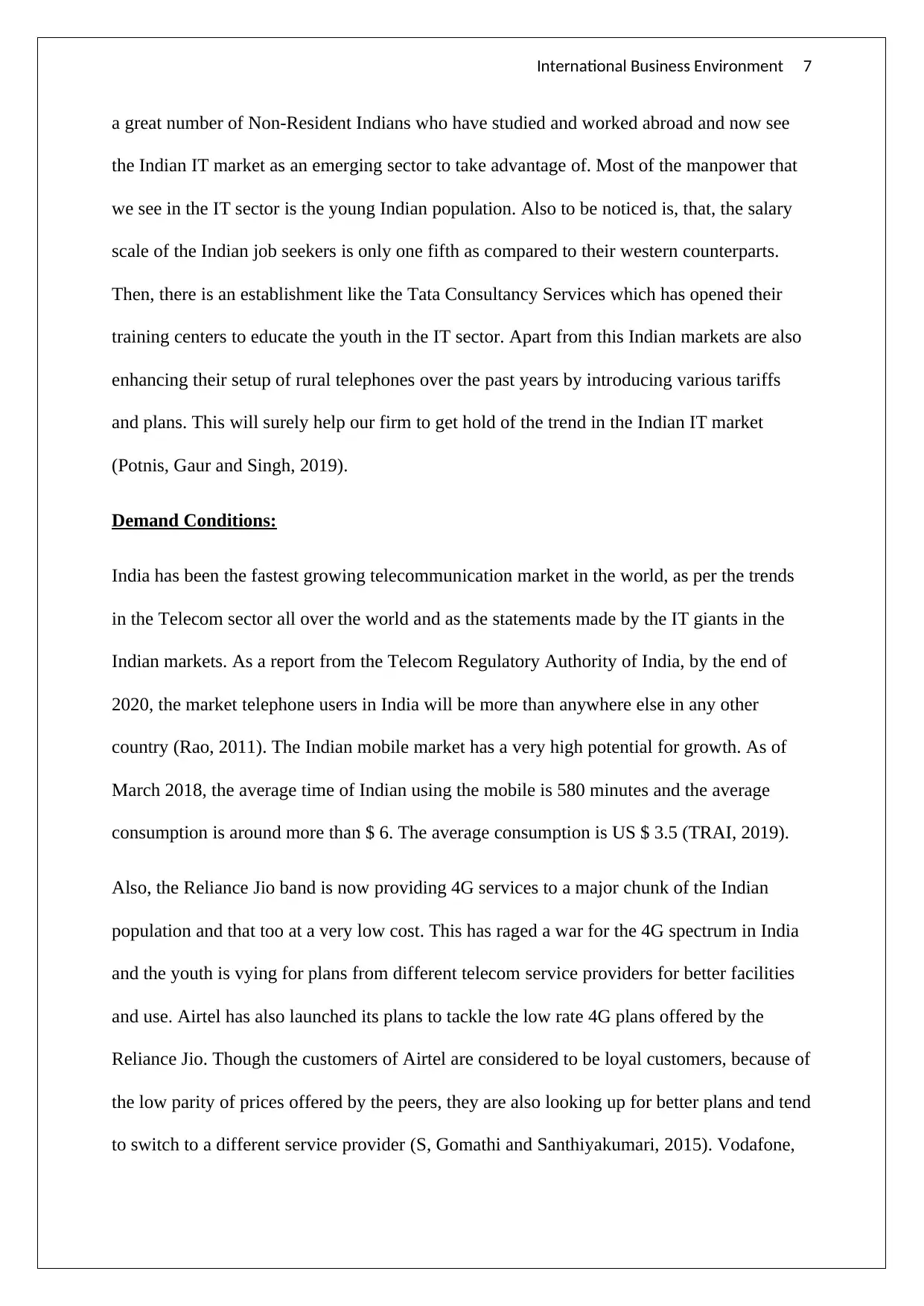
International Business Environment 7
a great number of Non-Resident Indians who have studied and worked abroad and now see
the Indian IT market as an emerging sector to take advantage of. Most of the manpower that
we see in the IT sector is the young Indian population. Also to be noticed is, that, the salary
scale of the Indian job seekers is only one fifth as compared to their western counterparts.
Then, there is an establishment like the Tata Consultancy Services which has opened their
training centers to educate the youth in the IT sector. Apart from this Indian markets are also
enhancing their setup of rural telephones over the past years by introducing various tariffs
and plans. This will surely help our firm to get hold of the trend in the Indian IT market
(Potnis, Gaur and Singh, 2019).
Demand Conditions:
India has been the fastest growing telecommunication market in the world, as per the trends
in the Telecom sector all over the world and as the statements made by the IT giants in the
Indian markets. As a report from the Telecom Regulatory Authority of India, by the end of
2020, the market telephone users in India will be more than anywhere else in any other
country (Rao, 2011). The Indian mobile market has a very high potential for growth. As of
March 2018, the average time of Indian using the mobile is 580 minutes and the average
consumption is around more than $ 6. The average consumption is US $ 3.5 (TRAI, 2019).
Also, the Reliance Jio band is now providing 4G services to a major chunk of the Indian
population and that too at a very low cost. This has raged a war for the 4G spectrum in India
and the youth is vying for plans from different telecom service providers for better facilities
and use. Airtel has also launched its plans to tackle the low rate 4G plans offered by the
Reliance Jio. Though the customers of Airtel are considered to be loyal customers, because of
the low parity of prices offered by the peers, they are also looking up for better plans and tend
to switch to a different service provider (S, Gomathi and Santhiyakumari, 2015). Vodafone,
a great number of Non-Resident Indians who have studied and worked abroad and now see
the Indian IT market as an emerging sector to take advantage of. Most of the manpower that
we see in the IT sector is the young Indian population. Also to be noticed is, that, the salary
scale of the Indian job seekers is only one fifth as compared to their western counterparts.
Then, there is an establishment like the Tata Consultancy Services which has opened their
training centers to educate the youth in the IT sector. Apart from this Indian markets are also
enhancing their setup of rural telephones over the past years by introducing various tariffs
and plans. This will surely help our firm to get hold of the trend in the Indian IT market
(Potnis, Gaur and Singh, 2019).
Demand Conditions:
India has been the fastest growing telecommunication market in the world, as per the trends
in the Telecom sector all over the world and as the statements made by the IT giants in the
Indian markets. As a report from the Telecom Regulatory Authority of India, by the end of
2020, the market telephone users in India will be more than anywhere else in any other
country (Rao, 2011). The Indian mobile market has a very high potential for growth. As of
March 2018, the average time of Indian using the mobile is 580 minutes and the average
consumption is around more than $ 6. The average consumption is US $ 3.5 (TRAI, 2019).
Also, the Reliance Jio band is now providing 4G services to a major chunk of the Indian
population and that too at a very low cost. This has raged a war for the 4G spectrum in India
and the youth is vying for plans from different telecom service providers for better facilities
and use. Airtel has also launched its plans to tackle the low rate 4G plans offered by the
Reliance Jio. Though the customers of Airtel are considered to be loyal customers, because of
the low parity of prices offered by the peers, they are also looking up for better plans and tend
to switch to a different service provider (S, Gomathi and Santhiyakumari, 2015). Vodafone,
Paraphrase This Document
Need a fresh take? Get an instant paraphrase of this document with our AI Paraphraser
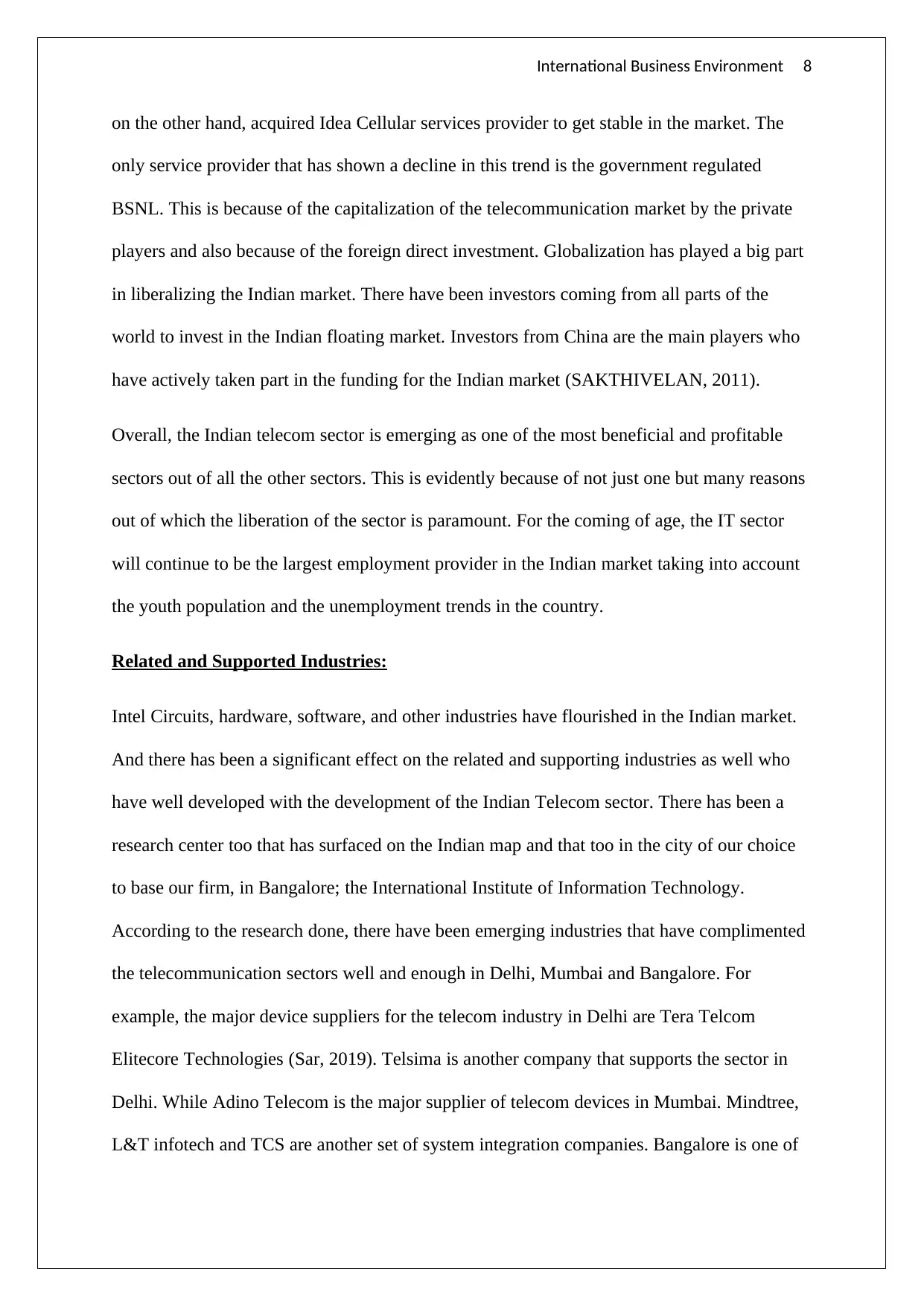
International Business Environment 8
on the other hand, acquired Idea Cellular services provider to get stable in the market. The
only service provider that has shown a decline in this trend is the government regulated
BSNL. This is because of the capitalization of the telecommunication market by the private
players and also because of the foreign direct investment. Globalization has played a big part
in liberalizing the Indian market. There have been investors coming from all parts of the
world to invest in the Indian floating market. Investors from China are the main players who
have actively taken part in the funding for the Indian market (SAKTHIVELAN, 2011).
Overall, the Indian telecom sector is emerging as one of the most beneficial and profitable
sectors out of all the other sectors. This is evidently because of not just one but many reasons
out of which the liberation of the sector is paramount. For the coming of age, the IT sector
will continue to be the largest employment provider in the Indian market taking into account
the youth population and the unemployment trends in the country.
Related and Supported Industries:
Intel Circuits, hardware, software, and other industries have flourished in the Indian market.
And there has been a significant effect on the related and supporting industries as well who
have well developed with the development of the Indian Telecom sector. There has been a
research center too that has surfaced on the Indian map and that too in the city of our choice
to base our firm, in Bangalore; the International Institute of Information Technology.
According to the research done, there have been emerging industries that have complimented
the telecommunication sectors well and enough in Delhi, Mumbai and Bangalore. For
example, the major device suppliers for the telecom industry in Delhi are Tera Telcom
Elitecore Technologies (Sar, 2019). Telsima is another company that supports the sector in
Delhi. While Adino Telecom is the major supplier of telecom devices in Mumbai. Mindtree,
L&T infotech and TCS are another set of system integration companies. Bangalore is one of
on the other hand, acquired Idea Cellular services provider to get stable in the market. The
only service provider that has shown a decline in this trend is the government regulated
BSNL. This is because of the capitalization of the telecommunication market by the private
players and also because of the foreign direct investment. Globalization has played a big part
in liberalizing the Indian market. There have been investors coming from all parts of the
world to invest in the Indian floating market. Investors from China are the main players who
have actively taken part in the funding for the Indian market (SAKTHIVELAN, 2011).
Overall, the Indian telecom sector is emerging as one of the most beneficial and profitable
sectors out of all the other sectors. This is evidently because of not just one but many reasons
out of which the liberation of the sector is paramount. For the coming of age, the IT sector
will continue to be the largest employment provider in the Indian market taking into account
the youth population and the unemployment trends in the country.
Related and Supported Industries:
Intel Circuits, hardware, software, and other industries have flourished in the Indian market.
And there has been a significant effect on the related and supporting industries as well who
have well developed with the development of the Indian Telecom sector. There has been a
research center too that has surfaced on the Indian map and that too in the city of our choice
to base our firm, in Bangalore; the International Institute of Information Technology.
According to the research done, there have been emerging industries that have complimented
the telecommunication sectors well and enough in Delhi, Mumbai and Bangalore. For
example, the major device suppliers for the telecom industry in Delhi are Tera Telcom
Elitecore Technologies (Sar, 2019). Telsima is another company that supports the sector in
Delhi. While Adino Telecom is the major supplier of telecom devices in Mumbai. Mindtree,
L&T infotech and TCS are another set of system integration companies. Bangalore is one of
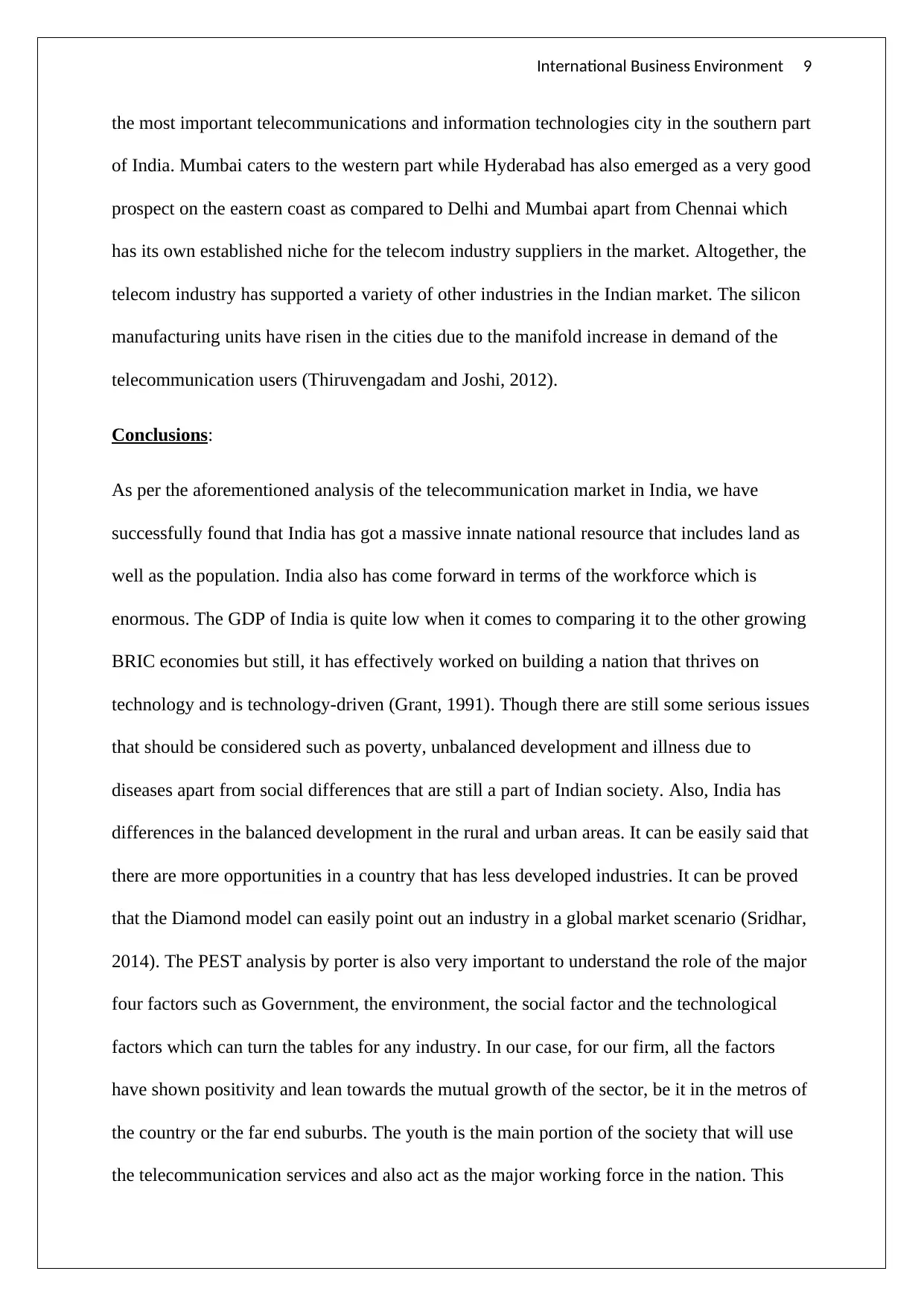
International Business Environment 9
the most important telecommunications and information technologies city in the southern part
of India. Mumbai caters to the western part while Hyderabad has also emerged as a very good
prospect on the eastern coast as compared to Delhi and Mumbai apart from Chennai which
has its own established niche for the telecom industry suppliers in the market. Altogether, the
telecom industry has supported a variety of other industries in the Indian market. The silicon
manufacturing units have risen in the cities due to the manifold increase in demand of the
telecommunication users (Thiruvengadam and Joshi, 2012).
Conclusions:
As per the aforementioned analysis of the telecommunication market in India, we have
successfully found that India has got a massive innate national resource that includes land as
well as the population. India also has come forward in terms of the workforce which is
enormous. The GDP of India is quite low when it comes to comparing it to the other growing
BRIC economies but still, it has effectively worked on building a nation that thrives on
technology and is technology-driven (Grant, 1991). Though there are still some serious issues
that should be considered such as poverty, unbalanced development and illness due to
diseases apart from social differences that are still a part of Indian society. Also, India has
differences in the balanced development in the rural and urban areas. It can be easily said that
there are more opportunities in a country that has less developed industries. It can be proved
that the Diamond model can easily point out an industry in a global market scenario (Sridhar,
2014). The PEST analysis by porter is also very important to understand the role of the major
four factors such as Government, the environment, the social factor and the technological
factors which can turn the tables for any industry. In our case, for our firm, all the factors
have shown positivity and lean towards the mutual growth of the sector, be it in the metros of
the country or the far end suburbs. The youth is the main portion of the society that will use
the telecommunication services and also act as the major working force in the nation. This
the most important telecommunications and information technologies city in the southern part
of India. Mumbai caters to the western part while Hyderabad has also emerged as a very good
prospect on the eastern coast as compared to Delhi and Mumbai apart from Chennai which
has its own established niche for the telecom industry suppliers in the market. Altogether, the
telecom industry has supported a variety of other industries in the Indian market. The silicon
manufacturing units have risen in the cities due to the manifold increase in demand of the
telecommunication users (Thiruvengadam and Joshi, 2012).
Conclusions:
As per the aforementioned analysis of the telecommunication market in India, we have
successfully found that India has got a massive innate national resource that includes land as
well as the population. India also has come forward in terms of the workforce which is
enormous. The GDP of India is quite low when it comes to comparing it to the other growing
BRIC economies but still, it has effectively worked on building a nation that thrives on
technology and is technology-driven (Grant, 1991). Though there are still some serious issues
that should be considered such as poverty, unbalanced development and illness due to
diseases apart from social differences that are still a part of Indian society. Also, India has
differences in the balanced development in the rural and urban areas. It can be easily said that
there are more opportunities in a country that has less developed industries. It can be proved
that the Diamond model can easily point out an industry in a global market scenario (Sridhar,
2014). The PEST analysis by porter is also very important to understand the role of the major
four factors such as Government, the environment, the social factor and the technological
factors which can turn the tables for any industry. In our case, for our firm, all the factors
have shown positivity and lean towards the mutual growth of the sector, be it in the metros of
the country or the far end suburbs. The youth is the main portion of the society that will use
the telecommunication services and also act as the major working force in the nation. This
⊘ This is a preview!⊘
Do you want full access?
Subscribe today to unlock all pages.

Trusted by 1+ million students worldwide
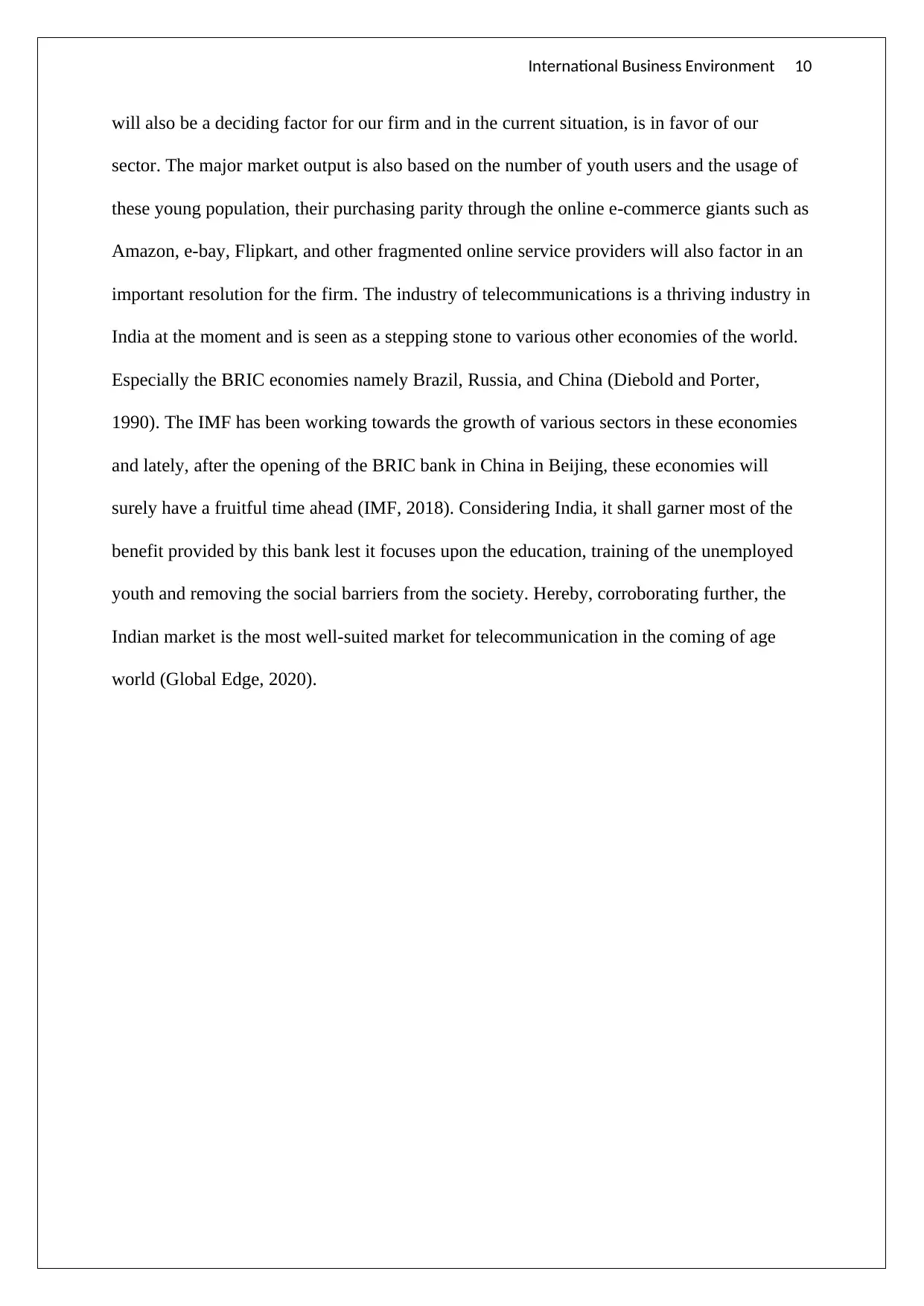
International Business Environment 10
will also be a deciding factor for our firm and in the current situation, is in favor of our
sector. The major market output is also based on the number of youth users and the usage of
these young population, their purchasing parity through the online e-commerce giants such as
Amazon, e-bay, Flipkart, and other fragmented online service providers will also factor in an
important resolution for the firm. The industry of telecommunications is a thriving industry in
India at the moment and is seen as a stepping stone to various other economies of the world.
Especially the BRIC economies namely Brazil, Russia, and China (Diebold and Porter,
1990). The IMF has been working towards the growth of various sectors in these economies
and lately, after the opening of the BRIC bank in China in Beijing, these economies will
surely have a fruitful time ahead (IMF, 2018). Considering India, it shall garner most of the
benefit provided by this bank lest it focuses upon the education, training of the unemployed
youth and removing the social barriers from the society. Hereby, corroborating further, the
Indian market is the most well-suited market for telecommunication in the coming of age
world (Global Edge, 2020).
will also be a deciding factor for our firm and in the current situation, is in favor of our
sector. The major market output is also based on the number of youth users and the usage of
these young population, their purchasing parity through the online e-commerce giants such as
Amazon, e-bay, Flipkart, and other fragmented online service providers will also factor in an
important resolution for the firm. The industry of telecommunications is a thriving industry in
India at the moment and is seen as a stepping stone to various other economies of the world.
Especially the BRIC economies namely Brazil, Russia, and China (Diebold and Porter,
1990). The IMF has been working towards the growth of various sectors in these economies
and lately, after the opening of the BRIC bank in China in Beijing, these economies will
surely have a fruitful time ahead (IMF, 2018). Considering India, it shall garner most of the
benefit provided by this bank lest it focuses upon the education, training of the unemployed
youth and removing the social barriers from the society. Hereby, corroborating further, the
Indian market is the most well-suited market for telecommunication in the coming of age
world (Global Edge, 2020).
Paraphrase This Document
Need a fresh take? Get an instant paraphrase of this document with our AI Paraphraser
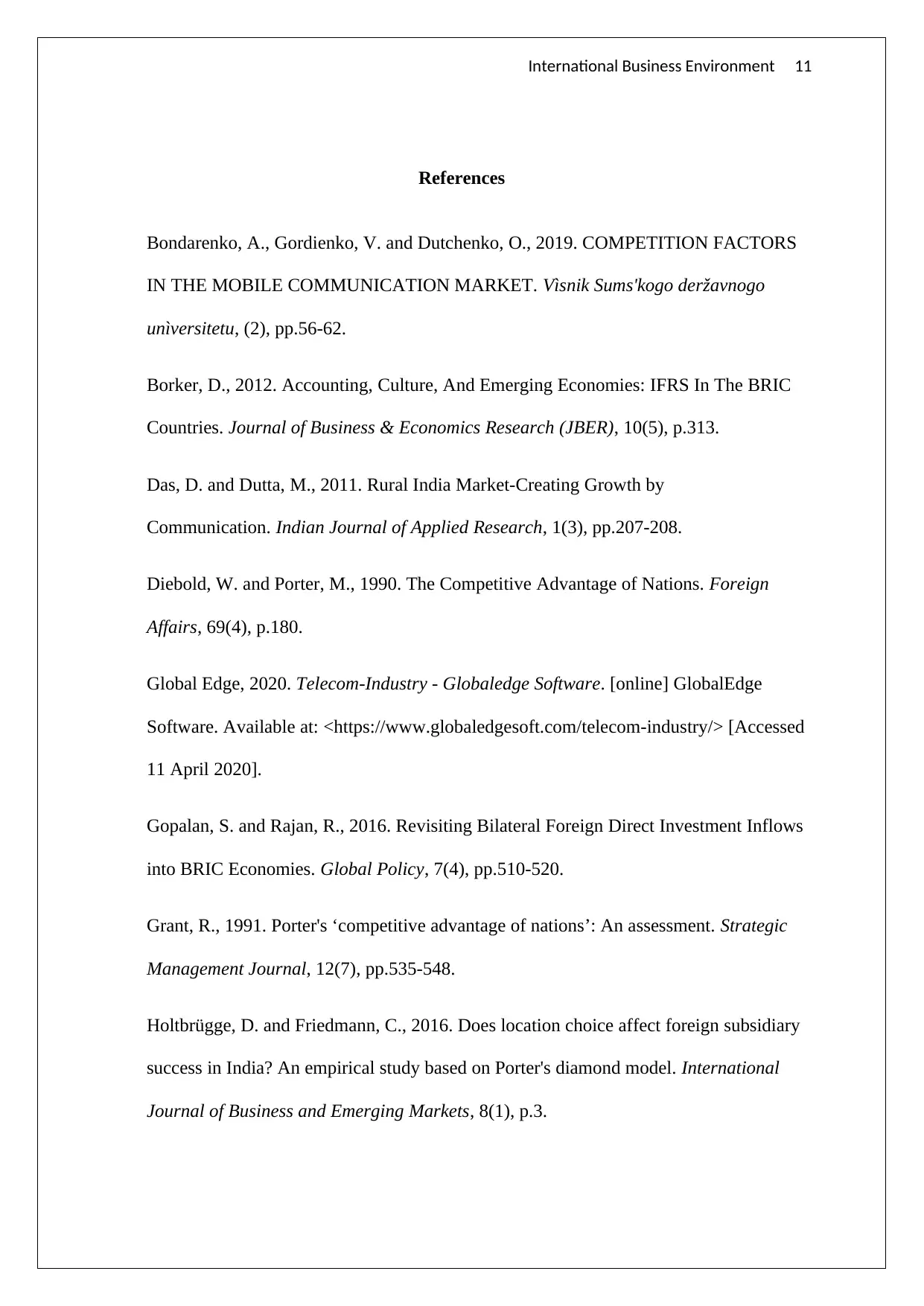
International Business Environment 11
References
Bondarenko, A., Gordienko, V. and Dutchenko, O., 2019. COMPETITION FACTORS
IN THE MOBILE COMMUNICATION MARKET. Vìsnik Sumsʹkogo deržavnogo
unìversitetu, (2), pp.56-62.
Borker, D., 2012. Accounting, Culture, And Emerging Economies: IFRS In The BRIC
Countries. Journal of Business & Economics Research (JBER), 10(5), p.313.
Das, D. and Dutta, M., 2011. Rural India Market-Creating Growth by
Communication. Indian Journal of Applied Research, 1(3), pp.207-208.
Diebold, W. and Porter, M., 1990. The Competitive Advantage of Nations. Foreign
Affairs, 69(4), p.180.
Global Edge, 2020. Telecom-Industry - Globaledge Software. [online] GlobalEdge
Software. Available at: <https://www.globaledgesoft.com/telecom-industry/> [Accessed
11 April 2020].
Gopalan, S. and Rajan, R., 2016. Revisiting Bilateral Foreign Direct Investment Inflows
into BRIC Economies. Global Policy, 7(4), pp.510-520.
Grant, R., 1991. Porter's ‘competitive advantage of nations’: An assessment. Strategic
Management Journal, 12(7), pp.535-548.
Holtbrügge, D. and Friedmann, C., 2016. Does location choice affect foreign subsidiary
success in India? An empirical study based on Porter's diamond model. International
Journal of Business and Emerging Markets, 8(1), p.3.
References
Bondarenko, A., Gordienko, V. and Dutchenko, O., 2019. COMPETITION FACTORS
IN THE MOBILE COMMUNICATION MARKET. Vìsnik Sumsʹkogo deržavnogo
unìversitetu, (2), pp.56-62.
Borker, D., 2012. Accounting, Culture, And Emerging Economies: IFRS In The BRIC
Countries. Journal of Business & Economics Research (JBER), 10(5), p.313.
Das, D. and Dutta, M., 2011. Rural India Market-Creating Growth by
Communication. Indian Journal of Applied Research, 1(3), pp.207-208.
Diebold, W. and Porter, M., 1990. The Competitive Advantage of Nations. Foreign
Affairs, 69(4), p.180.
Global Edge, 2020. Telecom-Industry - Globaledge Software. [online] GlobalEdge
Software. Available at: <https://www.globaledgesoft.com/telecom-industry/> [Accessed
11 April 2020].
Gopalan, S. and Rajan, R., 2016. Revisiting Bilateral Foreign Direct Investment Inflows
into BRIC Economies. Global Policy, 7(4), pp.510-520.
Grant, R., 1991. Porter's ‘competitive advantage of nations’: An assessment. Strategic
Management Journal, 12(7), pp.535-548.
Holtbrügge, D. and Friedmann, C., 2016. Does location choice affect foreign subsidiary
success in India? An empirical study based on Porter's diamond model. International
Journal of Business and Emerging Markets, 8(1), p.3.
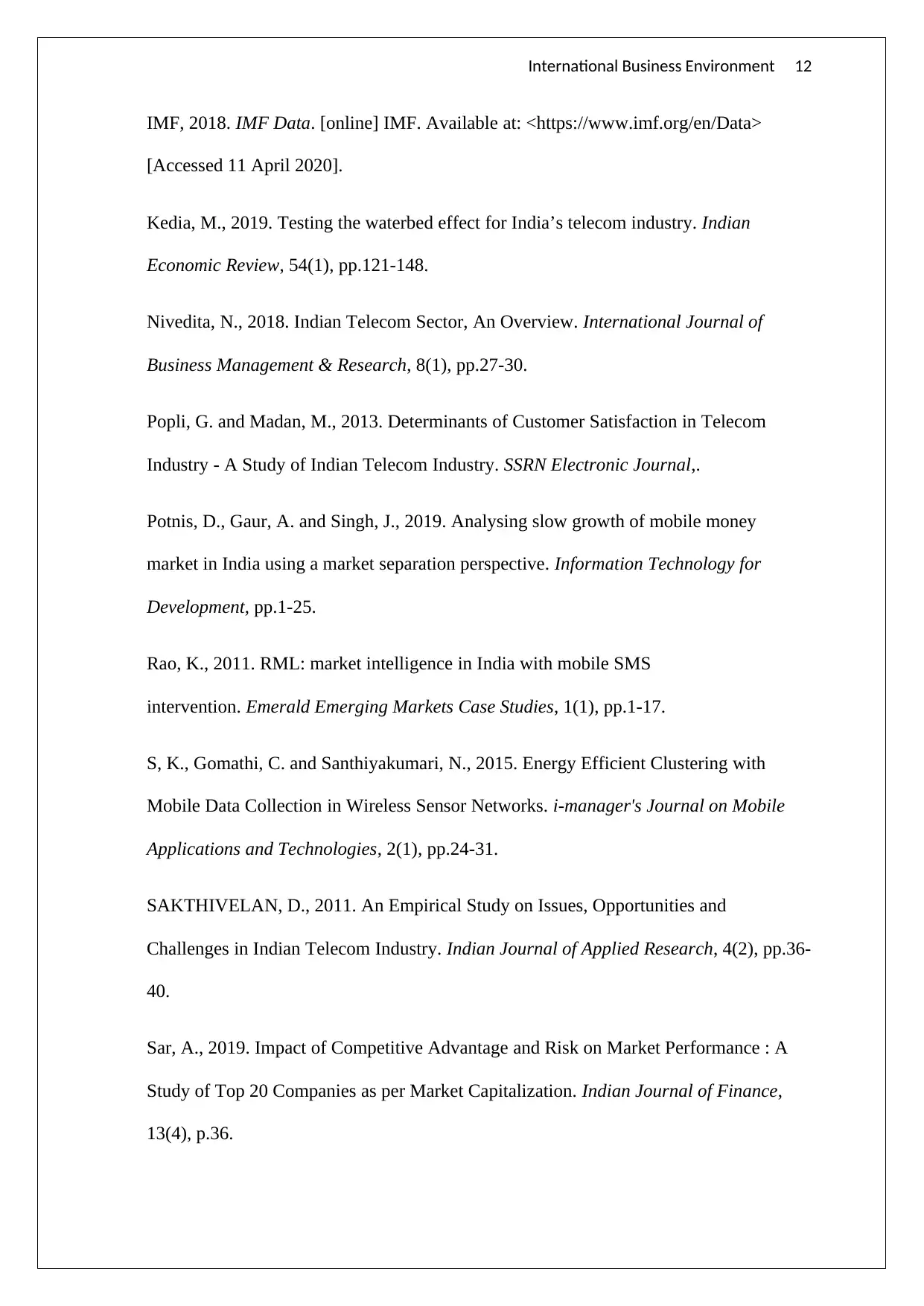
International Business Environment 12
IMF, 2018. IMF Data. [online] IMF. Available at: <https://www.imf.org/en/Data>
[Accessed 11 April 2020].
Kedia, M., 2019. Testing the waterbed effect for India’s telecom industry. Indian
Economic Review, 54(1), pp.121-148.
Nivedita, N., 2018. Indian Telecom Sector, An Overview. International Journal of
Business Management & Research, 8(1), pp.27-30.
Popli, G. and Madan, M., 2013. Determinants of Customer Satisfaction in Telecom
Industry - A Study of Indian Telecom Industry. SSRN Electronic Journal,.
Potnis, D., Gaur, A. and Singh, J., 2019. Analysing slow growth of mobile money
market in India using a market separation perspective. Information Technology for
Development, pp.1-25.
Rao, K., 2011. RML: market intelligence in India with mobile SMS
intervention. Emerald Emerging Markets Case Studies, 1(1), pp.1-17.
S, K., Gomathi, C. and Santhiyakumari, N., 2015. Energy Efficient Clustering with
Mobile Data Collection in Wireless Sensor Networks. i-manager's Journal on Mobile
Applications and Technologies, 2(1), pp.24-31.
SAKTHIVELAN, D., 2011. An Empirical Study on Issues, Opportunities and
Challenges in Indian Telecom Industry. Indian Journal of Applied Research, 4(2), pp.36-
40.
Sar, A., 2019. Impact of Competitive Advantage and Risk on Market Performance : A
Study of Top 20 Companies as per Market Capitalization. Indian Journal of Finance,
13(4), p.36.
IMF, 2018. IMF Data. [online] IMF. Available at: <https://www.imf.org/en/Data>
[Accessed 11 April 2020].
Kedia, M., 2019. Testing the waterbed effect for India’s telecom industry. Indian
Economic Review, 54(1), pp.121-148.
Nivedita, N., 2018. Indian Telecom Sector, An Overview. International Journal of
Business Management & Research, 8(1), pp.27-30.
Popli, G. and Madan, M., 2013. Determinants of Customer Satisfaction in Telecom
Industry - A Study of Indian Telecom Industry. SSRN Electronic Journal,.
Potnis, D., Gaur, A. and Singh, J., 2019. Analysing slow growth of mobile money
market in India using a market separation perspective. Information Technology for
Development, pp.1-25.
Rao, K., 2011. RML: market intelligence in India with mobile SMS
intervention. Emerald Emerging Markets Case Studies, 1(1), pp.1-17.
S, K., Gomathi, C. and Santhiyakumari, N., 2015. Energy Efficient Clustering with
Mobile Data Collection in Wireless Sensor Networks. i-manager's Journal on Mobile
Applications and Technologies, 2(1), pp.24-31.
SAKTHIVELAN, D., 2011. An Empirical Study on Issues, Opportunities and
Challenges in Indian Telecom Industry. Indian Journal of Applied Research, 4(2), pp.36-
40.
Sar, A., 2019. Impact of Competitive Advantage and Risk on Market Performance : A
Study of Top 20 Companies as per Market Capitalization. Indian Journal of Finance,
13(4), p.36.
⊘ This is a preview!⊘
Do you want full access?
Subscribe today to unlock all pages.

Trusted by 1+ million students worldwide
1 out of 13
Related Documents
Your All-in-One AI-Powered Toolkit for Academic Success.
+13062052269
info@desklib.com
Available 24*7 on WhatsApp / Email
![[object Object]](/_next/static/media/star-bottom.7253800d.svg)
Unlock your academic potential
Copyright © 2020–2025 A2Z Services. All Rights Reserved. Developed and managed by ZUCOL.





